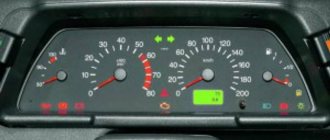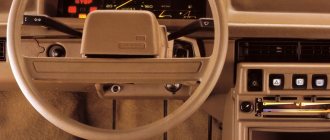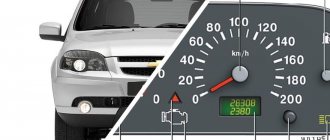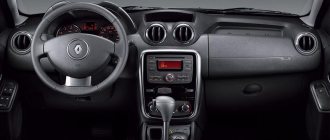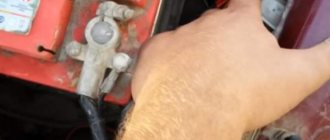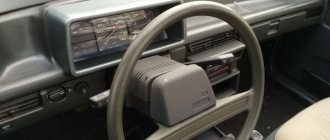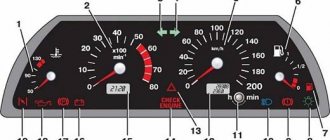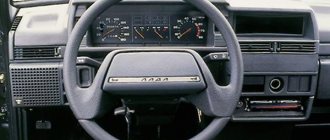The instrumentation of the VAZ 2110 has remained virtually unchanged. The board displays basic information about the status of on-board systems to the driver in real time. Depending on the configuration, the old-style dashboard has a simplified design than the versions on new cars.
The differences in configurations are also minimal. Cars with engines with 8 valves or 16 are identical. The only difference will be on engines such as injector or carburetor.
The most common “tens” device has only 19 indicators and gauges. Each element is responsible for its own part of the on-board equipment.
Indication symbols
As you know, all the lights on the control panel come on when the ignition is turned on, and then, when the engine is already running, most of them go out. But when one remains on or blinks, this cannot but be alarming, because not everyone can immediately figure out what malfunctions this indicates, which of the systems needs urgent repairs.
Let's look at the designations of the instrument panel of the VAZ 2110. You should know that regardless of whether the panel is new or old on your car, the designations are almost the same, but the indicators may be located slightly differently.
Instrument panel VAZ 2110
Top part
So let's start from left to right. First, the top part of the control panel:
- Side scale from 50 to 130 and arrow. Shows the temperature of antifreeze (antifreeze) in the engine cooling system;
- Almost round scale (0 – 80) and arrow. Tachometer showing engine speed;
- Two arrows at the top, almost in the middle of the control panel - turn signals (right, left);
- Speedometer. Well, this device, probably everyone knows, shows the speed at which the car is moving;
- A side scale with an arrow and, most often, two images of a filling column (white and red). Instead of a red column there may be a yellow light. This is an indicator of the fuel level in the tank. If the red column (yellow light) lights up, it means that there is very little fuel left in the tank - no more than 7 liters, urgent refueling is required.
How are the icons on the installed instrument panel deciphered?
In addition to the instruments, the panel also has various icons that light up when there is a malfunction in the form of electronic indicators. They have the following meanings for the driver:
- ABS sign. This indicator lights up only when the engine starts and immediately goes out. It can also light up if there are problems with the operation of the anti-lock elements in the brake system.
- Front airbag indicator. Will light up when there is a malfunction with the airbags attached to the front panel of the car.
- An indicator that reminds you to put on your seat belt. It will light up when you start the engine and will remain on until you fasten your seat belt.
- Airbag warning light. Lights up when the airbag of the front pair of passengers is turned off.
- Heated rear window indicator. It will light up before turning on the heating on the rear window.
- Low beam icon.
- High beam indicator.
- Sign for turning on the rear fog lights.
- Front fog lamp sign.
- An indicator that turns on when there is a malfunction in the electric amplifier.
- Signal lamp that operates when the doors are not closed.
- Lamp for adjusting the fuel level in the tank. It lights up only if there is fuel for 15-20 minutes of driving.
- Indicator for left and right turn signals of the vehicle.
- An indicator that turns on when the engine cooling system overheats.
- Indicator lamps that turn on when the batteries are low charged.
- A light called “CHECK ENGINE.” Lights up when a malfunction occurs with the engine control system.
- Signal indicators that turn on when the parking brake is used or when a breakdown occurs in the brake system.
- Indicator of low pressure and level of engine oil in the lubrication system.
- The preheating system malfunction light (specifically responsible for the glow plugs).
- A warning light that appears when the electronic engine starting system of a car is blocked.
Advice: if one of the indicators associated with the wheels lights up, then first bleed the brakes on the VAZ-2110. and then check the system again. If the indicator on the on-board panel disappears, it means that the problem was solved by repairing the brake system.
Bottom part
Let's look at the indicators at the bottom of the control panel. If they don’t light up, it means the machine is working normally, and when any of them lights up, this indicates a malfunction in certain components. Most often, this is a signal that repairs are needed, and the sooner the better. From left to right:
- The indicator on the far left at the bottom is the air damper light (if you have a carburetor engine);
- Icon in the form of an oil can. If this light comes on, it means there is insufficient oil pressure in the engine. An alarming signal. You need to stop, find the reason;
- A round icon with the letter P inside on the control panel indicates that you have the parking brake on, which, as you know, should be turned off when moving away;
- Indicator of a fault related to the generator or battery (a symbolic image of the battery is shown on the indicator). Perhaps the battery is not charging from the generator, there is an open circuit, or the generator belt is loose or broken. In any case, your intervention and repairs are needed, otherwise troubles cannot be avoided;
- If the engine is running and the Check Engine indicator is on on the control panel, this is the most unpleasant thing for the driver, since it indicates serious malfunctions in the engine. In general, when this indicator lights up, it is recommended to stop driving and turn off the engine. Most likely it needs repairs;
- Typically there is a red triangle above the Check Engine. It lights up when the “hazard light” is on - an emergency signal sign;
- The headlight light indicates that the high beam is on. Designed to control headlights: when an oncoming car appears, do not forget to switch to low beam;
- A very important indication icon on the front panel (in a red circle) is a signal that there is not enough brake fluid. Perhaps it is leaking somewhere, which it is advisable to find out as soon as possible and, if necessary, carry out urgent repairs and replenish the level;
- The icon of a burning light is a control for turning on the dimensions;
- In addition to the indicated lights, the front control panel has time indicators (and a button for setting hours and minutes) as well as a display that shows the total and daily mileage. On the new panel, this display may be narrow.
Additional panel
The additional front panel of the new-style BSK control has indicators:
- An oil can is shown. If the light works, check the oil level;
- An icon lights up, which, with some imagination, can be “identified” as working wipers. This indicates that there is not enough windshield washer fluid in the tank;
- Conventional image of a thermometer over a container with liquid - high temperature of antifreeze;
- A crossed out light, which the arrow points to, is a sign that the brake light or parking lights are not working;
- If the light with the image of a wheel with brake pads lights up, it is quite possible that the pads are worn out and require replacement;
- The sign of a man with a seat belt indicates that the seat belt should be fastened.
Panel BSK VAZ 2110
Removal and modification
Here's a quick look at the device and control panel icons. If for some reason she refuses, don’t immediately panic. Most often, the reason is the absence of contacts in some place in the wiring. But of course, if you wish, you can completely change or tune the panel.
For example, remove the cover and replace the light bulbs with brighter LEDs. Such a panel works brighter and the signals sent by the car will be more noticeable to the driver. If desired, you can install a more solid europanel, which will transform the interior.
To remove the panel you need:
- Disconnect the “-” wire from the battery;
- Remove the shield by unscrewing the screws;
- Remove the fastenings of the control panel to the trim, remove the instrument cluster from the socket;
- Remove the glass mask;
- Disconnect the wires from the block;
- Make changes to the instrument panel or replace it with a new one. Reassemble everything in reverse order.
Many car owners would like to replace the VAZ 2112 instrument panel with a Europanel. This replacement brings more comfort and capabilities to driving a vehicle. What a Europanel is and how to install it on a VAZ 2111 and the twelfth model will be discussed in the article.
Description of the VAZ 2110 dashboard buttons
Well, let’s immediately move on to the description of the buttons on the dashboard of the VAZ 2110.
Instrument panel of a VAZ 2110 car - the buttons located on it are marked on the arrows
As you can see from the screenshot, there are only 4 buttons on the instrument panel of the VAZ 2110 - let's move on to their description.
- Button to turn on/off the front fog lights.
- Turn on/off outdoor lighting.
- Heated rear window
- Button for turning on/off the rear fog lights.
In addition to the buttons located on the dashboard, there are others that are located under the stove, next to the radio in the cabin. Let's find out their functions:
Instrument panel VAZ 2110 - description of the buttons next to the stove
Many VAZ 2110 owners wonder why these 4 buttons, which are located on the dashboard under the stove, are needed. The answer will seem rather banal to you:
These buttons actually do not play any function; I think the engineers working on the ten wanted to add electric windows to the car, but for some reason they forgot to do this.
Okay, it was a joke! In fact, these buttons are responsible for the following:
- Turning recirculation on/off
- Button for installing additional equipment (for example, power windows)
- Turning the hazard warning lights on/off
- Button for installing additional equipment (for example, power windows)
Description and location of indicators on the panel
After 2006, a new dashboard was installed on VAZ 2112 cars. For reasons that are not entirely clear, any description of it includes the prefix “euro”, probably due to its modernity and quality.
But in order to use it, you need to know the symbols, which are not always easy to understand even from the instructions. You can often only guess what this or that indicator and light bulb mean. To make this task easier for yourself, pay attention to the diagram of the instrument panel below and its explanations.
Description of the panel
- Arrow pointer. Intended to indicate the approximate coolant temperature. The data is obtained from a sensor that is installed between the cylinder head and the thermostat. This allows you to obtain accurate data. The sections have a range of 20 degrees, the lower level is 50, and the upper level is 130.
- Tachometer. Its purpose is known to any driver - to show engine revolutions per minute. Sections of 5 units, digitized every 10 units. To get the real value, add a couple of zeros to the number. Starting from 55, the engine enters the red zone in terms of revolutions.
- Left turn signal indicator.
- A similar indicator for the right turn signal.
- Speedometer. It is of the induction type and receives speed data from the sensor on the gearbox. Unfortunately, it’s definitely not very high; the error can be up to 5 km/h or even more.
- Fuel level indicator. The sensor is located directly in the tank.
- A warning light indicating a dangerously low fuel level.
- Low beam indicator.
- Lamp for monitoring the amount of brake fluid.
- High beam indicator.
- Lever for adjusting the clock.
- Total (odometer) and daily mileage.
- Alarm.
- Failure of electronic systems leading to critical engine failure.
- Clock and thermometer.
- Low battery charging voltage.
- Handbrake warning lamp.
- Critical oil pressure level.
- Fuel mixture enricher indicator.
Possible malfunctions: signs and causes
What problems can a car owner encounter:
- Some of the light bulbs on the dashboard do not work. If one or more light sources fail, then most likely this is due to burnt-out lamps. The problem is solved by replacing devices.
- The backlight has stopped functioning altogether, while all instruments and indicators light up. Apparently, the reason must be sought in the inoperability of the brightness control itself; it could have broken down. With constant use of this regulator, its connection contact with the on-board network may have come loose, so you need to check the wiring. The reason may also be a blown fuse located in the mounting block.
- The backlight does not turn on, and none of the indicators or sensors work. Perhaps the panel itself was “covered” or the block with the wires connected to the panel was damaged. You need to remove the device and carefully check all circuits.
- The speedometer does not work - the needle does not rise or rises, but very slowly and jerkily. With such a problem, the cause should be sought in the speed sensor, which can be electronic or mechanical. If it is mechanical, then check the condition of the tips that go into the speedometer itself and the gearbox. The end of the cable connected to the speedometer often wears out; you can try to solve the problem by wrapping a piece of food foil around this end. If the sensor is electronic, then you need to check the quality of the contacts.
- Indicators, for example, turn signals or optics, do not turn on. It is necessary to check the functionality of the steering column switches for low and high beam headlights, as well as turns.
- The fuel volume sensor does not function, the needle does not move or has risen all the way and does not fall. In the first case, the reason may lie in the failure of the controller itself, located in the fuel tank. You need to find the sensor and check its functionality. In the second case, the possible cause is a short circuit in the electrical circuit; you will need to test the wiring with a tester.
- The tachometer does not work. Again, the reason must be sought in the crankshaft position sensor - it could have failed, or the contact could have come loose from it. Most often, the reason for the malfunction of the sensors on the device is associated with oxidation of the contacts; they should be checked first.
Installation and repair instructions
Replacing the panel, especially if you are installing it on an old VAZ 2112, is a certain difficulty. Older machines do not have some of the functions for which the panel has buttons. The wiring may need to be worked on.
Tools and materials
Standard tools will be required.
But a certain amount of additional materials is needed:
- you will need plugs for extra buttons that are not needed on an old car;
- air duct;
- various inserts, buttons (5 pieces) and pads;
- a new wiring harness suitable for the wiring diagram;
- brackets for mounting the instrument panel;
Algorithm of actions
First you need to remove the old panel. This is done in the same way as on other models of VAZ cars.
When installing, you need to replace the ignition switch with a decimal or Kalinovsky one, depending on how many terminals there are on the block to the lock. You can leave the old one and rearrange the wires, but the new one will work and look better.
The instrument panel wiring needs to be replaced. Also, connect the dimensions with additional two wires in Ш4/13 and Ш3/13 on the mounting block. This applies to older units with 11 relay spaces.
Depending on whether it is an injector or a carburetor, the connection has its own nuances. If you bought a solid factory panel, then instructions should be included with it. Briefly, it can be noted that the injector is not equipped with a speed sensor, please take this into account when installing.
The car's electrical circuit can be of great help. If it is not there, you can find it on the Internet. There are some differences between the VAZ 21124, 2111 and other car variants, so find yours.
If the instrument panel does not work after turning it on, check that the wiring is connected correctly - this is usually the error.
Video “Europanel on VAZ 2112”
Rice. 1–4. Controls
The location of the controls is shown in Fig. 1–4.
1 – front door glass blower nozzle.
2 – side nozzles of the interior ventilation and heating system.
3 – glove box cover. To access the glove compartment, press the lock handle in the direction of the arrow.
5 – display unit of the on-board control system.
6 – radio socket cover.
7 – cigarette lighter. To use, press the chuck until it locks into place. After about 20 s. The cartridge automatically returns to its original position, ready for use.
8 – front ashtray.
9 – lining of the floor tunnel.
10 – control units.
11 – parking brake lever. By moving the lever up, the brake pads of the rear wheels are activated. To return the lever to its original position, press the button on the end of the lever handle. In case of emergency, the parking brake can be used while driving to slow down the vehicle or used simultaneously with the service brakes.
12 – gear shift lever. The gear shift diagram is printed on the lever handle.
13 – accelerator pedal.
14 – socket for connecting a portable lamp.
15 – brake pedal.
16 – clutch pedal.
17 – ignition switch.
18 – steering column tilt adjustment handle. To install the steering column in a position convenient for steering, release the handle down and, after selecting the optimal tilt, return the handle to its uppermost (starting) position.
19 – hood lock drive handle.
20 – sound signal switch.
21 – mounting block cover.
22 – switch for the trunk lock drive (tailgate). Installed on some manufactured cars. To open the trunk lid (tailgate), press the button.
23 – mounting block lock button.
24 – headlight hydraulic corrector. A device that allows you to adjust the angle of the headlight beam depending on the vehicle load so that oncoming drivers are not dazzled.
25 – lever for switching direction indicators and headlights.
26 – external lighting switch. When you press the button to the first fixed position, the side lights and rear license plate lights are turned on, and before the second, the headlight circuits are additionally energized.
27 – front fog lamp switch. Installed on a car equipped with fog lights, which can be turned on and off by pressing a button.
28 – the indicator lamp for turning on the fog lights lights up when the fog lights are turned on.
29 – instrument cluster.
30 – the indicator lamp for turning on the rear fog light lights up when the rear fog lights are turned on.
31 – rear fog light switch. The fog lamps in the rear lights are turned on by pressing the button in conditions of limited visibility and turn off when pressed again.
32 – the rear window heating indicator lamp lights up when the rear window heating is turned on.
33 – rear window heating switch. Switching the glass heating on and off is done by successively pressing the key.
34 – instrument lighting regulator. Rotating the handle adjusts the brightness of the instrument lighting and the illumination of symbols.
35 – immobilizer warning sensor. Installed on a vehicle with a fuel injection system equipped with an electronic anti-theft system, and is designed to transmit a secret code from the working code key through the immobilizer unit to the engine control controller.
Europanel
Note Some versions of cars of later releases (in particular, models produced) are equipped with a modified instrument panel - the so-called “European panel”.
- Left side deflector.
- Outdoor lighting buttons.
- Instrument cluster.
- Egnition lock.
- Right steering column switch (windshield wipers and washers).
- Hazard warning light button.
- Instrument lighting control knob.
- Immobilizer sensor with indicator.
- Rear window heating switch.
- Plugs (reserve places for installing switches for additional equipment).
- Central deflectors.
- Heater control panel.
- Covers for niches for installing car radios.
- Right side deflector.
- Left steering column switch (direction indicators and headlights).
- Hood release lever.
- Steering wheel.
- Clutch pedal.
- Brake pedal.
- Accelerator pedal.
- Socket for connecting a portable lamp.
- Gear shift lever.
- Ashtray cover.
- Cigarette lighter.
- Glove box.
- Parking brake lever.
- Side light switch.
- Indicator for turning on side lights.
- Indicator for turning on headlights.
- Headlight switch.
- Indicator for turning on the rear fog lights.
- Rear fog lamp switch.
- Plugs (reserve places for installing switches for additional equipment).
- Headlight level control.
- Tachometer.
- Left turn signal indicator.
- Speedometer.
- Right turn signal indicator.
- Coolant temperature gauge.
- Fuel level indicator.
- Left indicator panel.
- Information display.
- Right indicator panel.
- Button for resetting the daily mileage counter and setting the clock.
Source: krutilvertel.com
